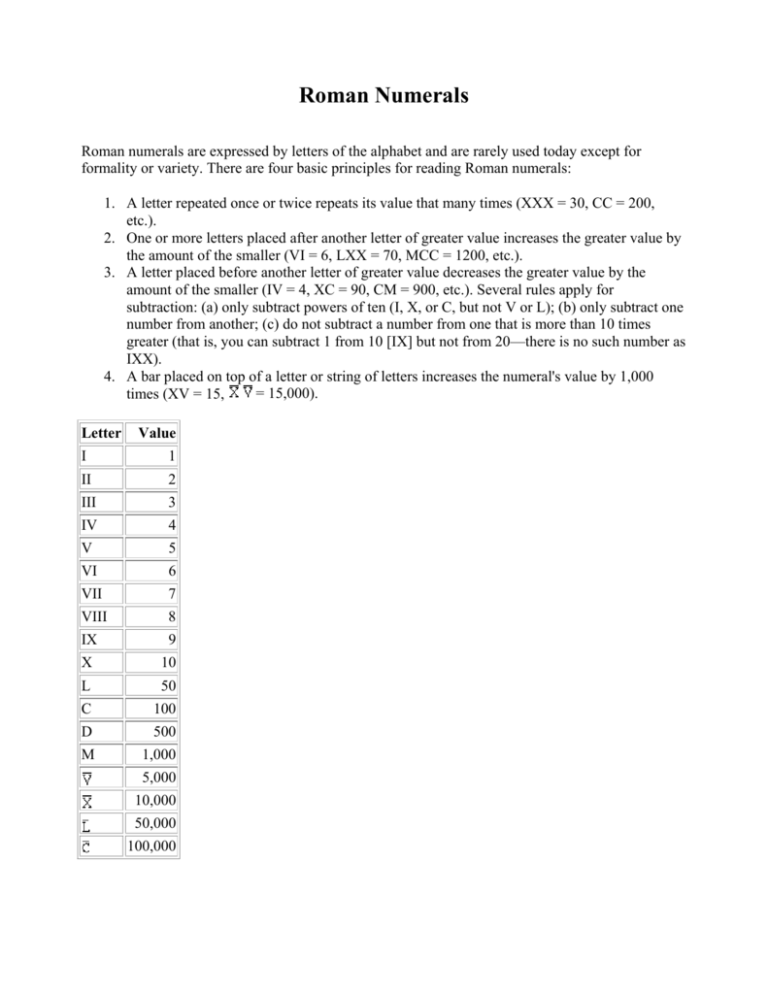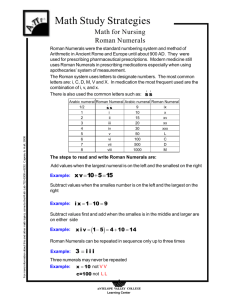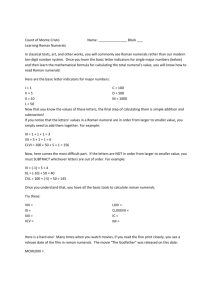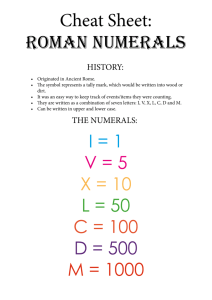Roman Numerals
advertisement

Roman Numerals Roman numerals are expressed by letters of the alphabet and are rarely used today except for formality or variety. There are four basic principles for reading Roman numerals: 1. A letter repeated once or twice repeats its value that many times (XXX = 30, CC = 200, etc.). 2. One or more letters placed after another letter of greater value increases the greater value by the amount of the smaller (VI = 6, LXX = 70, MCC = 1200, etc.). 3. A letter placed before another letter of greater value decreases the greater value by the amount of the smaller (IV = 4, XC = 90, CM = 900, etc.). Several rules apply for subtraction: (a) only subtract powers of ten (I, X, or C, but not V or L); (b) only subtract one number from another; (c) do not subtract a number from one that is more than 10 times greater (that is, you can subtract 1 from 10 [IX] but not from 20—there is no such number as IXX). 4. A bar placed on top of a letter or string of letters increases the numeral's value by 1,000 = 15,000). times (XV = 15, Letter Value I 1 II 2 III 3 IV 4 V 5 VI 6 VII 7 VIII 8 IX 9 X 10 L 50 C 100 D 500 M 1,000 5,000 10,000 50,000 100,000 Subtractive Principle: Any numeral is counted positively unless there's a larger numeral anywhere to its right, in which case it is counted negatively. However, proper Roman numbers are subject to the following restrictions about the applicability of the subtractive principle. The use of the subtractive principle has always been optional. Its systematic use is fairly modern. For example, it's acceptable to use IIII instead of IV, as is usually done on clockfaces (to "balance" their left and right halves, so we're told). The subtractive principle (a subtrahend (the smaller number) preceding, i.e., to the left of, a minuend (the larger number)) may apply: • Only to a numeral (the subtrahend) which is a power of ten (I, X or C). For example, "VL" is not a valid representation of 45 (XLV is correct). • Only when the subtrahend preceeds a minuend no more than ten times larger. For example, "IL" is not a valid representation of 49 (XLIX is correct). • Only if any numeral preceeding the subtrahend is at least ten times larger. For example, "VIX" is not a valid representation of 14 (XIV is correct), and "IIX" is not correct for 8 (VIII is correct). • Only if any numeral following the minuend is smaller than the subtrahend. For example, "XCL" is not a valid representation of 140 (CXL is correct). Roman Numerals Worksheet Write the Roman numerals as Hindu-Arabic (our system) numbers. Show work. 1.) MMXXXVI 2.) MCMXXIV 3.) CMLX 4.) CXLVII 5.) DCDC






